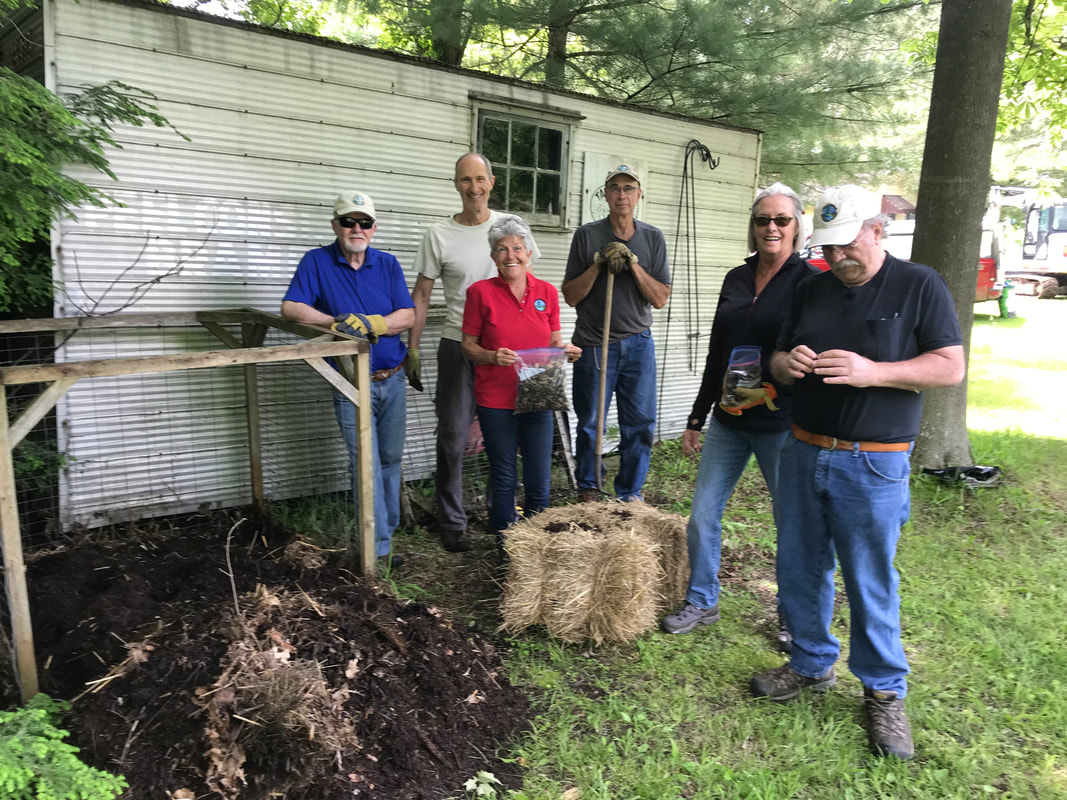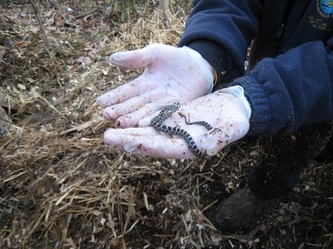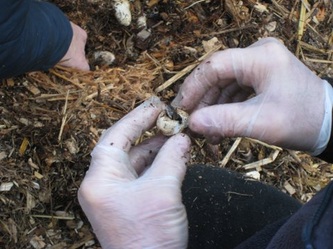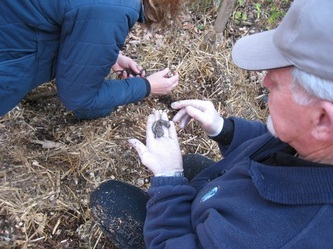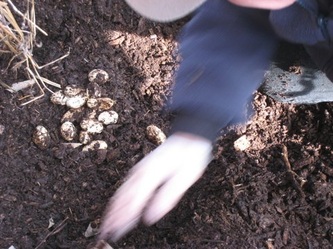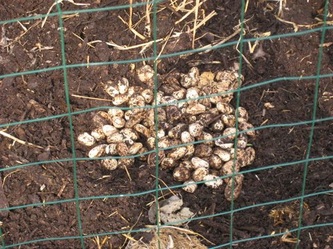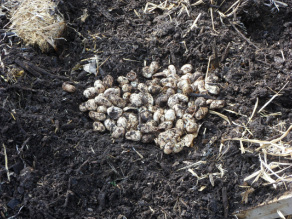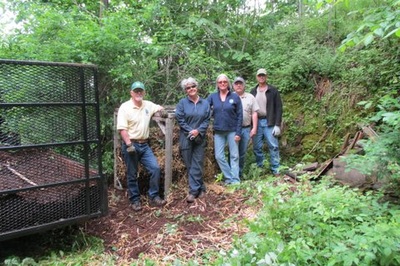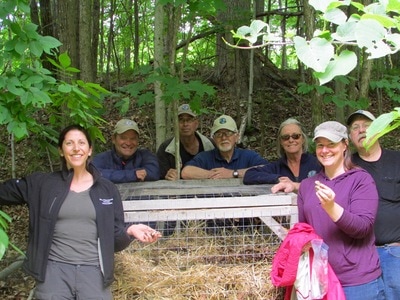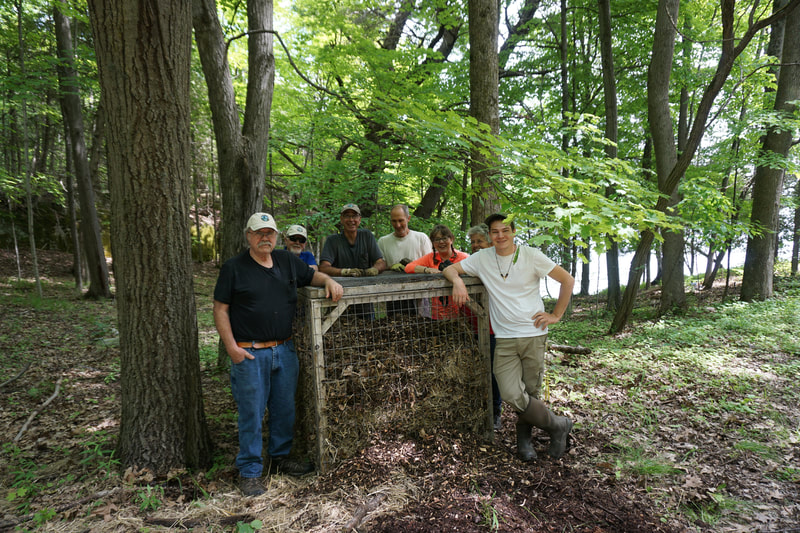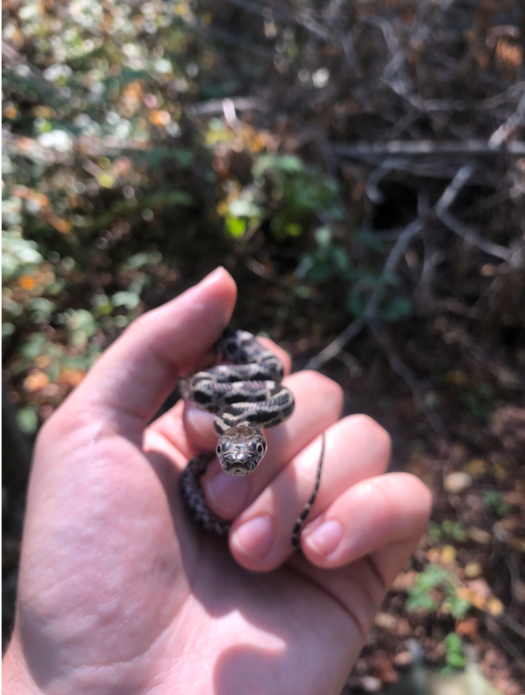
Young Gray Rat Snake just emerging while nesting box was being checked last fall.
Canada’s longest snake has recently had a name change, the snake commonly known as the Black ratsnake is now called the Gray ratsnake. The name change is a result of genetics that make the snakes found in this area different from the Black ratsnakes commonly found in the United States. The Gray Ratsnake is listed as “threatened” on the Ontario Species at Risk list.
In 2005 with funding support from OMNR(CFWIP), Garnet Baker and Dwayne Struthers designed and built 12 wood framed, wire mesh nesting boxes to provide protection from egg predators. The structures have been deployed throughout Leeds County. They are filled annually with a variety of compost substrates designed to maintain a temperature around 30 degrees Celsius, which is necessary for egg incubation.
The program has also attempted to look into possible rational for nesting site choices of gravid female snakes. The program has been a tremendous success in that it has produced sites where snakes are actively and successfully laying eggs and this is the only known example in the area where this type of habitat provision and use has been documented. Even locations that have not been used by gravid female snakes can provide information as to possible nest site preferences.
The structures have been deployed throughout the eastern portion of Leeds-Grenville. They are filled annually with a variety of compost substrates designed to maintain a temperature around 30 degrees Celsius, which is necessary for egg incubation.
Since 2009 evidence of over 1530 successful hatchings (egg shells) have been found in the nest boxes that are monitored annually.
Previous years also helped provide additional information about the little known phenomenon of parasitism on gray ratsnake eggs from the larvae of the postulated carrion beetle. At one location where nesting boxes have been successful, evidence on some of the eggs showed that they had been destroyed by the beetle larvae which emerge and predate upon the incubating eggs. This site is used communally by gravid ratsnakes and one belief is that these communally used sites can be more susceptible to this parasitoid.
Traditionally, the nest box sites were monitored by LGSC in the late fall but it was determined from previous years of monitoring that on several occasions we were finding eggs that were yet to hatch or juveniles were just emerging. It was determined that this could risk the successful emergence of juvenile snakes and the timing for nest box monitoring would be done in the spring in the future as not to disturb emerging snakes or alter incubating temperature regimes.Anecdotal information shows that at two sites being used there may be common factors leading to the success. Both sites have observed snakes in the area, are located adjacent to building structures that could be considered safe areas for female snakes to forage and the adjacent structures could be improving moisture content in the nest box material. Successful sites have well composted mixes of hay, woodchips and soil.
Work will continue over the coming years to further enhance efforts for the recovery of the Frontenac Arch population of the Gray Ratsnake.
If you are interested in building and installing a nesting box please consult the Plans for the Nesting Box.
For more information on how landowners can help with the recovery efforts please consult the Landowner's Guide on the next page.
In 2005 with funding support from OMNR(CFWIP), Garnet Baker and Dwayne Struthers designed and built 12 wood framed, wire mesh nesting boxes to provide protection from egg predators. The structures have been deployed throughout Leeds County. They are filled annually with a variety of compost substrates designed to maintain a temperature around 30 degrees Celsius, which is necessary for egg incubation.
The program has also attempted to look into possible rational for nesting site choices of gravid female snakes. The program has been a tremendous success in that it has produced sites where snakes are actively and successfully laying eggs and this is the only known example in the area where this type of habitat provision and use has been documented. Even locations that have not been used by gravid female snakes can provide information as to possible nest site preferences.
The structures have been deployed throughout the eastern portion of Leeds-Grenville. They are filled annually with a variety of compost substrates designed to maintain a temperature around 30 degrees Celsius, which is necessary for egg incubation.
Since 2009 evidence of over 1530 successful hatchings (egg shells) have been found in the nest boxes that are monitored annually.
- 2005 - 9
- 2009 – 24
- 2010 – 80
- 2011 – 151
- 2013 – 140
- 2014 - 185
- 2015 - 234
- 2016 - 200
- 2017 - 175
- 2018 - 350
Previous years also helped provide additional information about the little known phenomenon of parasitism on gray ratsnake eggs from the larvae of the postulated carrion beetle. At one location where nesting boxes have been successful, evidence on some of the eggs showed that they had been destroyed by the beetle larvae which emerge and predate upon the incubating eggs. This site is used communally by gravid ratsnakes and one belief is that these communally used sites can be more susceptible to this parasitoid.
Traditionally, the nest box sites were monitored by LGSC in the late fall but it was determined from previous years of monitoring that on several occasions we were finding eggs that were yet to hatch or juveniles were just emerging. It was determined that this could risk the successful emergence of juvenile snakes and the timing for nest box monitoring would be done in the spring in the future as not to disturb emerging snakes or alter incubating temperature regimes.Anecdotal information shows that at two sites being used there may be common factors leading to the success. Both sites have observed snakes in the area, are located adjacent to building structures that could be considered safe areas for female snakes to forage and the adjacent structures could be improving moisture content in the nest box material. Successful sites have well composted mixes of hay, woodchips and soil.
Work will continue over the coming years to further enhance efforts for the recovery of the Frontenac Arch population of the Gray Ratsnake.
If you are interested in building and installing a nesting box please consult the Plans for the Nesting Box.
For more information on how landowners can help with the recovery efforts please consult the Landowner's Guide on the next page.
